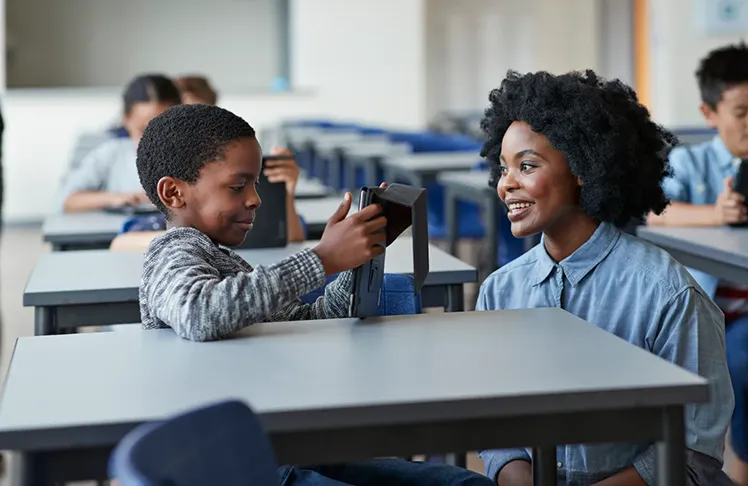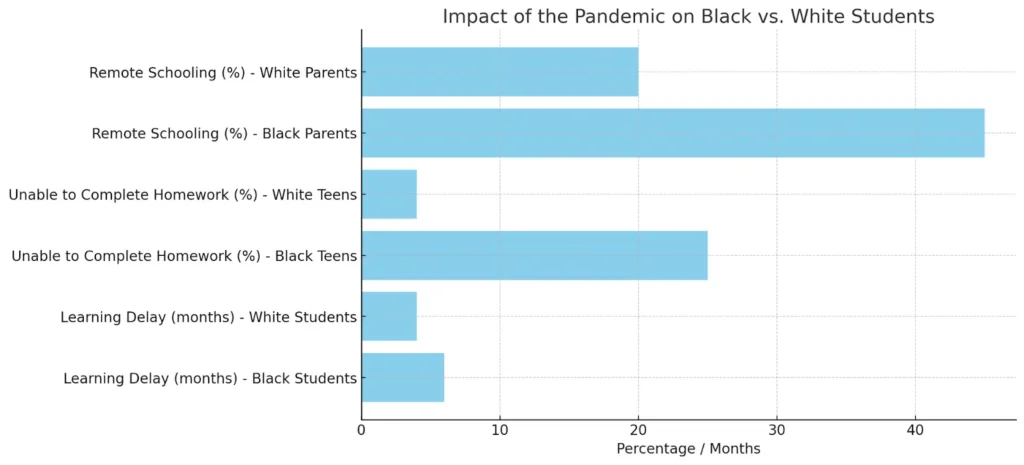

This article is one of a series of articles produced by Word in Black through support provided by the Chan Zuckerberg Initiative. Word In Black is a collaborative of 10 Black-owned media outlets across the country.
As schools turn to artificial intelligence to tackle pandemic learning loss, adopting AI-based educational technology raises key questions about equity. Darryl Haynes, a seventh-grade English teacher in Jacksonville, Florida, says the current state of AI isn’t entirely ready to serve the needs of Black students in an unbiased way.
“I think AI could help address learning loss on the surface, but there’s a real concern about whether these tools are truly equitable,” he says. “Younger students, especially Black students, may not have the skills to effectively interact with AI, and I’m concerned it could limit their achievement goals. I think we will get there, but we need to ensure AI is being designed with these students in mind from the start.”
Black K-12 students like the ones Haynes teaches suffered greater learning losses during the pandemic than their white peers, further exacerbating existing achievement gaps. A report by McKinsey & Company revealed that Black students, grades 1-6, were six months behind in learning by the end of the 2020-2021 school year, compared to four months for white students. Additionally, the national absenteeism rate increased by 1.5% for Black 8th- through 12th graders.
Access to digital learning resources was also uneven for Black students during the pandemic. A Pew Research survey found that 25% of Black teens were unable to complete their homework due to a lack of reliable computer or internet access, compared to 4% of white teens. Moreover, Black students were more likely to attend schools that remained closed for more extended periods, — with 45% of Black parents reporting that their children’s schools were remote for most or all of the 2020-2021 school year, compared to 20% of white parents.
AI promises personalized learning to close the resulting learning gaps, but its success hinges on equitable implementation. Experts say there’s a risk of perpetuating bias if a racial equity lens isn’t considered.

A New Approach to Personalized Learning
In many ways, AI has offered personalized learning solutions that traditional teaching and intervention methods have struggled to provide. For instance, AI-driven tutoring systems have demonstrated a 24% improvement in student learning outcomes — a crucial advantage for Black students who may attend underfunded schools.
Furthermore, AI’s data-driven approach allows educators to identify learning gaps and allocate resources more effectively. A report in ArtSmart found that 65% of teachers in K-12 schools use AI to analyze student data and determine areas for improvement. This could potentially prove beneficial in districts with high percentages of Black students, where funding and resources are often limited.
The Challenges of AI Implementation
Despite these benefits, concerns around the potential for AI to perpetuate existing biases can’t be ignored.
“The goal is for our computers to make humanlike judgments and perform tasks to make our lives easier, but if we’re not careful, our machines will replicate our racism, too,” education experts Andre Perry and Nicol Turner-Lee warned in 2019.
AI systems are only as unbiased as the data they’re trained on, and for Black students, if the underlying data reflects societal biases, this could mean the continuation or worsening of educational inequities.
“Systemic racism and discrimination are already embedded in our educational systems,” Perry and Turner Lee explained. “Developers must intentionally build AI systems with a racial equity lens if the technology is going to disrupt the status quo,” they added.

Access to AI technology is another critical issue. Black students are more likely to face barriers to accessing the necessary devices and internet connectivity required to benefit from AI tools.
In the rural South, where the digital divide is greatest, about 38% of Black households didn’t have home internet access, which is a higher percentage than White people in the same region (23%) and the national average (22%), according to a 2021 report from the Joint Center for Political and Economic Studies.
A National Concern
The challenges of using AI to address learning loss among Black students are not unique to any single district or state. Schools nationwide are grappling with how to use AI effectively and equitably. There are no federal guidelines for using AI in schools, so states like Mississippi, where educational disparities along racial lines have long existed, have created their own — all in the hopes that AI could provide a much-needed boost to struggling schools.
Cade Brumley, Louisiana’s superintendent of education, recently requested $30 million from the state legislature to expand in-school tutoring, which includes AI tutoring options. Among them is Amira, an AI-based tutoring program used by about 74,000 students in 360 schools across the state.
The Los Angeles Unified School District has also begun using AI to develop personalized learning plans for its students, a strategy expected to help mitigate the learning loss experienced by many students during the pandemic. In mid-March, the nation’s second-largest school district began rolling out “Ed,” an AI assistant offering personalized learning plans and resources based on a student’s current academic scores. It also helps parents monitor grades, attendance, upcoming tests, and more.
Where Do We Go From Here?
AI holds promise for addressing learning loss among Black students, offering personalized learning and data-driven resource allocation that could help close the achievement gap. However, without equitable implementation and access, the tools designed to help bridge learning gaps could widen instead.
As Misty Freeman, an educator and unconscious bias coach, told the National Education Association in February, “Black students face unconscious bias without technology. So having developers of AI that do not further perpetuate that bias is important.”















